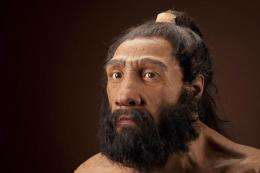April 21, 2010 report
Neanderthals may have interbred with humans twice

(PhysOrg.com) -- Extinct human species such as Neanderthals may still be with us, at least in our DNA, and this may help explain why they disappeared from the fossil record around 30,000 years ago.
An examination of the DNA of 1,983 people from around the globe suggests that extinct human species such as Homo neanderthalensis or Homo heidelbergensis interbred with our own ancestors during two separate periods, and their genes remain in our DNA today. The research was carried out by a group of genetic anthropologists from the University of New Mexico, and leader of the team, Jeffrey Long, said the findings mean Neanderthals did not completely disappear, but “there is a little bit of Neanderthal left over in almost all humans.”
The subjects of the study were drawn from 99 population groups in the Americas, Oceania, Europe, Asia, and Africa, and the researchers analyzed over 600 microsatellite positions on the genome, which are sections that can be used rather like fingerprints. Doctoral student Sarah Joyce then developed an evolutionary tree to explain the genetic variations found in the microsatellite positions.
The results were unexpected, but Joyce said the best explanation for the variations was that our human ancestors and the archaic species interbred during two periods after the first Homo sapiens had left Africa: the first in the Mediterranean around 60,000 years ago, and the second in eastern Asia about 45,000 years ago. The group found no evidence of the interbreeding in the DNA of modern Africans included in the study.
The findings suggest that after the first interbreeding populations migrated from the Mediterranean to North America, Europe and Asia. A second interbreeding in Asia then altered the genome of the people who went on to migrate to Oceania.
The findings were presented on 17th April at the American Association of Physical Anthropologists’ annual meeting in Albuquerque, New Mexico, where they created a great deal of interest among other researchers in the field, who had been attempting to explain some curious variations in the genome. One researcher, Linda Vigilant from the Max Planck Institute for Evolutionary Anthropology in Leipzig, Germany, said the findings may help explain what she called “subtle deviations” in the genetic variations in the Pacific region.
Other researchers from the Max Planck Institute, led by Svante Pääbo, finished sequencing the first draft of the Neanderthal genome last year. (See the PhysOrg article here.) The results are expected to be published soon and may shed more light on the possibility of interbreeding. Earlier research suggested interbreeding did not occur, but unlike Pääbo’s latest research these early results were not based on an analysis of the complete genome.
© 2010 PhysOrg.com

















